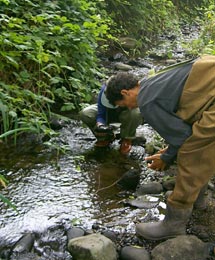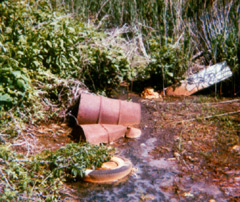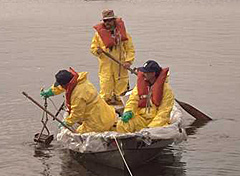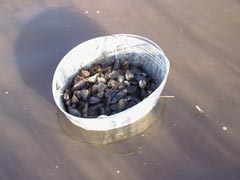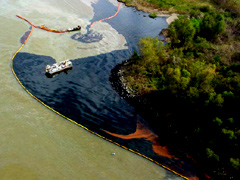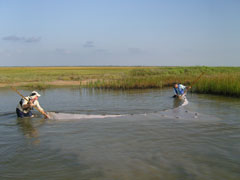|
|
Contaminants can impact natural resources, public health, and the economy. Most contaminants enter the environment from industrial and commercial facilities; oil and chemical spills; non-point sources such as roads, parking lots, and storm drains; and wastewater treatment plants and sewage systems. Many hazardous waste sites and industrial facilities have been contaminated for decades and continue to impact the environment.
NOAA acts as a trustee for coastal and marine resources under the authority of the Clean Water Act, the Comprehensive Environmental Response, Compensation and Liability Act, the National Marine Sanctuaries Act, the Coastal Zone Management Act, and the Oil Pollution Act of 1990. In addition, the National Oil and Hazardous Substances Pollution Contingency Plan (NCP) identifies the Department of Commerce as the primary federal trustee for protecting and restoring coastal resources affected by oil or hazardous materials. The NCP also describes NOAA’s role in providing scientific support during response activities and participating in domestic and international planning and response activities.
As part of NOAA’s responsibilities as a natural resource trustee, NOS response and restoration experts evaluate and address contaminants in the coastal environment. When contaminants threaten or harm aquatic species, make them unsafe to eat, or degrade their habitat, NOS experts work with partners to evaluate risks and injuries, develop strategies to reduce contaminant loads, and reduce the risk to species. The experts also monitor the effectiveness of cleanup actions and design and implement projects to restore natural resources. In some cases, NOS scientists and economists conduct natural resource damage assessments (NRDA) to determine the nature and extent of damage to natural resources and the level of restoration necessary to restore the resources to a healthier state. Often, NOS works with the parties responsible for the contamination to ensure that the damaged coastal and marine resources are restored. NOS Clean-up and Restoration Tools
To build state and local capacities for evaluating coastal contamination and developing clean-up and restoration solutions, NOS has developed publicly accessible, site-specific geographic information system-based tools called Watershed Database and Mapping Projects. NOS also provides sediment screening tools and guidance to help coastal decision makers evaluate contaminated sediments. NOS scientists and experts conduct research and operate several assessment and monitoring programs to investigate the trends, biological effects, and toxicity of contamination in coastal waters. The marine ecotoxicology research program focuses on the coastal habitats of the Southeastern United States. The program aims to establish links between land use and the presence of chemical contaminants in the marine environment. NOS's Center for Coastal Monitoring and Assessment manages the National Status and Trends Program (NS&T), which conducts long-term monitoring and documents the environmental quality of the nation’s coastal areas. The NS&T Mussel Watch Project annually collects mussels and oysters from more than 300 sites throughout the nation, analyzing these samples along with periodically collected sediment cores. A Bioeffects Team conducts studies to determine the incidence, severity, and breadth of contamination in living resources in coastal waters.
NOS addresses nonpoint source pollution through its Coastal Nonpoint Pollution Control Program. Nonpoint source pollution occurs when untreated sewage from boats, pets, and failing septic systems and stormwater runoff that picks up fertilizers, lawn chemicals, herbicides, salt from roadways, oil and gasoline drain into streams and rivers that empty into estuaries and coastal waters. States and territories with approved coastal zone management programs are developing and implementing coastal programs that are designed to reduce the amount of nonpoint source pollution in our waterways.
Lavaca Bay From 1965 to 1979, ALCOA’s Point Comfort plant, located on Lavaca Bay, Texas, produced chlorine gas and sodium hydroxide using mercury cathodes. Wastewater containing mercury was discharged into Lavaca Bay, located on the Gulf Coast, midway between Houston and Corpus Christi, Texas. Lavaca Bay sediments were contaminated with mercury, polycyclic aromatic hydrocarbons, and polychlorinated biphenyls. Elevated levels of mercury in finfish and crabs prompted closures of fisheries within specific areas of the site in 1988.
The oyster reef and wetlands were created or preserved to compensate for the interim loss of ecological services from natural reef and wetland habitat and losses caused by remedial actions in Lavaca Bay. Construction of the 11-acre oyster reef began April 13, 2005, and monitoring in late spring 2005 found oysters rapidly growing in the middle of the bay. The constructed reef has been designed to be ecologically similar to nearby reefs and to maximize habitat value. Seventy acres of salt marsh were created using the latest science from the NOAA Galveston Laboratory and as part of the Aransas National Wildlife Refuge, add to the foraging area of endangered whooping cranes. Both the reef and salt marsh benefit a wide range of biological resources, including finfish, shrimp, crabs, mussels, oysters, many species of reef-dwelling invertebrates, shore birds, and migratory wildfowl. And, to compensate the fishing and boating public for lost recreational opportunities during the fishery closures, Alcoa, working with the City of Port Lavaca, built several boat ramps, fishing piers, docks, and parking areas around the bay. The new spirit of cooperation among resource agencies and the local industries and community is bringing Lavaca Bay back to life. ALCOA has spent about $110 million on cleanup activities and projects to offset the injuries to fish and wildlife and to compensate for losses of recreational fishing in Lavaca Bay. Today, oysters are ready for harvest on the reef; oystermen culling at the edge of the reef will help the reef expand from its present 11 acres to approximately 22 acres. The 70-acre marsh constructed adjacent to the Aransas National Wildlife Refuge is thriving and is already home to fish and shrimp. Alligators have moved into the upper, fresher parts and rattlesnakes bask at the edge of the prairie, while cranes feed nearby. The fishing community has been enthusiastic in using the lighted piers and docks to access improved recreational use of the bay.
|
|
||||||||||||||||||||||||||||||
- NOS Program Offices
- Center for Operational Oceanographic Products and Services
- National Centers for Coastal Ocean Science
- NOAA Coastal Services Center
- National Geodetic Survey
- Office of Coast Survey
- Office of National Marine Sanctuaries
- Office of Ocean and Coastal Resource Management
- Office of Response and Restoration

Revised November 01, 2007
| Questions, Comments? Contact Us | Report
Error | Disclaimer | About
the Site | User Survey
National Oceanic and Atmospheric
Administration | U.S.
Department of Commerce | USA.gov
http://oceanservice.noaa.gov/topics/coasts/contaminants/welcome.html

